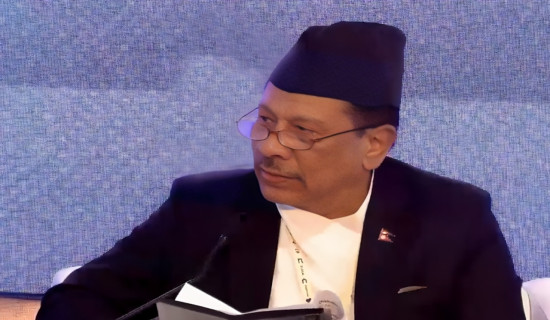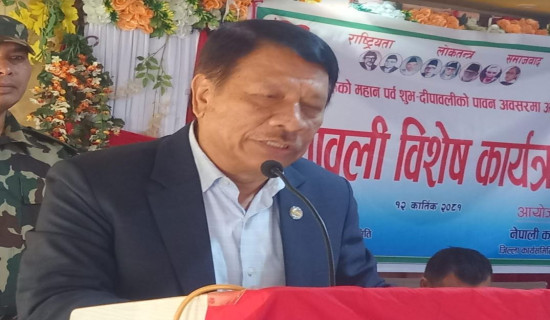- Wednesday, 6 November 2024
Economic indicators better, report of NRB shows
By Laxman Kafle,Kathmandu, Mar. 13: The external sector has been steadily improving due to contraction in imports and increase in remittance inflows. A current macroeconomic and financial report based on the first seven months of the current fiscal year 2022/23 published by the Nepal Rastra Bank Sunday showed that major economic indicators -- foreign currency reserves, balance of payment, current account and remittance inflows are improved.
Foreign currency reserves rise to Rs. 1,383 bn According to the report, gross foreign exchange reserves increased by 13.8 per cent to Rs. 1,383.33 billion in mid-February 2023 from Rs. 1,215.80 billion in mid-July 2022.
In the US dollar terms, the gross foreign exchange reserves increased by 10.2 per cent to 10.50 billion in mid-February 2023 from 9.54 billion in mid-July 2022. Of the total foreign exchange reserves, reserves held by NRB increased by 16.2 per cent to Rs. 1228.05 billion in mid-February 2023 from Rs. 1056.39 billion in mid-July 2022.
Reserves held by banks and financial institutions (except NRB) decreased by 2.6 per cent to Rs. 155.28 billion in mid-February 2023 from Rs. 159.41 billion in mid-July 2022.
The share of Indian currency in total reserves stood at 22.4 per cent in mid-February 2023. Based on the imports of seven months of 2022/23, the foreign exchange reserves of the banking sector are sufficient to cover the prospective merchandise imports of 10.8 months, and merchandise and service imports of 9.4 months.
Remittances of Rs. 690 billion received Remittance inflows increased by 27.1 per cent to Rs. 689.88 billion in the review period against a decrease of 4.4 per cent in the same period of the previous year.
In the US dollar terms, remittance inflows increased by 16.4 per cent to 5.30 billion in the review period against a decrease of 5.3 per cent in the same period of the previous year.
Remittance inflows increased by 24.3 per cent to Rs.585.08 billion in the review period against a decrease of 5 per cent in the same period of the previous year. In the US dollar terms, remittance inflows increased 13.9 per cent to 4.50 billion in the review period against a decrease of 5.7 per cent in the same period of the previous year.
In the month of Magh alone, around Rs. 105.8 billion of remittances have been received. Similarly, around Rs. 104.58 billion of remittances were received in the month of Poush.
Number of Nepali workers (institutional and individual-new) taking approval for foreign employment increased by 57.3 per cent to 314,767 in the review period. The number of Nepali workers (renew entry) taking approval for foreign employment increased by 10.1 per cent to 167,708 in the review period.
It had increased by 265.9 percent in the same period of the previous year.Net transfer increased by 25.2 per cent to Rs. 759.11 billion in the review period. Such a transfer had decreased by 3.7 per cent in the same period of the previous year.
BoP surplus up
Meanwhile, balance of payments (BOP) remained at a surplus of Rs. 133.21 billion in the review period compared to a deficit of Rs. 247.03 billion in the same period of the previous year.
In the US dollar terms, the BOP remained at a surplus of 1.01 billion in the review period against a deficit of 2.07 billion in the same period of the previous year. Not only the balance of payment, but also the current account recorded significant improvement.
The current account deficit which was Rs. 411.34 billion in the first seven months of the last fiscal year dropped to Rs. 29.64 billion by the end of February of the current fiscal year.
In the US dollar terms, the current account registered a deficit of 234.6 million in the review period compared to deficit of 3.45 billion in the same period last year, said the NRB.
In the review period, capital transfer decreased by 15.2 per cent to Rs. 5.35 billion and net foreign direct investment (FDI) remained Rs. 1.04 billion. In the same period of the previous year, capital transfer and net FDI amounted to Rs. 6.31 billion and Rs. 16.29 billion respectively.
During the review period, due to decline in imports, trade deficit decreased by 18.7 per cent to Rs. 825.73 billion during the seven months of 2022/23. Imports also decreased by 19.9 per cent to Rs. 919.17 billion against an increase of 42.8 per cent a year ago.
Exports also decreased by 29 per cent to Rs. 93.43 billion against an increase of 88.3 per cent in the same period of the previous year.

.png)















